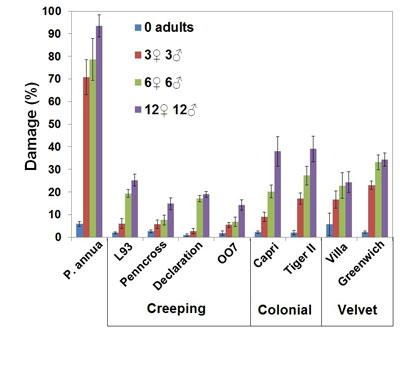Research confirms that annual bluegrass sustains significantly more annual bluegrass weevil (ABW) damage compared to bentgrasses. Four weeks after the highest density of adult introduction (12 female and 12 male), cumulative damage on the left compared to the control on the right for annual bluegrass was greater than ‘Declaration’ creeping bentgrass.
Annual bluegrass weevil (ABW) is a serious and expanding pest of short cut turfgrass on golf courses. Annual bluegrass (Poa annua) is the most suitable host plant for ABW and severely damaged by larval feeding. At Rutgers University, scientists provide clear evidence of bentgrass resistance or tolerance to ABW. When comparing annual bluegrass to bentgrass, bentgrasses were 1) less suitable and not preferred for egg laying; 2) less suitable for larval development; and 3) could tolerate higher larval densities with less visible damage. However, females laid eggs in the bentgrasses even if annual bluegrass was available, and ABW developed from eggs to pupae on all bentgrasses tested. Among all tested bentgrasses species, creeping bentgrasses were most resistant and tolerant to ABW.
On the golf course, damage to turfgrass occurs from the cumulative effects of adult and larval feeding on grass stems and leaves. In a 2013 greenhouse experiment, researchers tested three different adult densities in the pots with annual bluegrass and eight bentgrass cultivars (3 different species). After one week, researchers removed the adults from the pots and allowed larval development to continue in the greenhouse. After four weeks, the scientists recorded the grass responses (quality and damage ratings) to ABW feeding. Grass leaves and stems were clipped, oven dried and silicon and fiber content analyzed. Results of the 2013 experiment were consistent with the previous findings—annual bluegrass sustained significantly more damage compared to the bentgrasses (See Photo).
In the pots with annual bluegrass, damage ratings ranged from 70 to 93% at the lowest and the highest adult densities, respectively (Figure 1).

|
| After four weeks of adult and larval feeding, the damage that occurred on annual bluegrass
(70 to 93%) was much greater compared to three bentgrass species (eight cultivars).
|
In contrast, even for the most susceptible bentgrass (colonial ‘Capri’ and ‘Tiger’ and velvet ‘Villa’ and ‘Greenwich’) damage ratings were at most 24% and 40% at the lowest and the highest densities. Scientists observed little damage (on average less than 20%) in creeping bentgrasses (‘Penncross’, ‘Declaration’ and ‘007’) even with the highest adult densities. Silicon and fiber content of leaf and stem tissue did not correlate with the larval stages recovered in the tested grasses, suggesting that they are not involved in bentgrass resistance. In fact, annual bluegrass and the most susceptible bentgrasses tended to have higher silicon and fiber concentrations in their tissues.
Source: Mike Kenna (mkenna@usga.org)
Additional Information:
Advancing integrated Management of Annual Bluegrass Weevil
Contact the Green Section Staff

